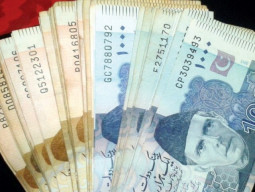
Despite robust market liquidity, the government raised Rs1,645 billion against maturity of Rs1,565 billion through the auction of treasury bills (T-bills) and Pakistan Investment Bonds (PIBs), while accepting a lower amount than its target for both instruments, reflecting a strategic approach to debt management.
The government raised Rs1,645 billion through the auction of T-bills and PIBs held on December 24, said Maaz Azam, Research Head of Optimus Capital.
Despite the strong market liquidity evident in the total bids received, the government accepted a lower amount than the target for both instruments, said AHL Director Equities Tahir Abbas.
In the T-bills auction, the State Bank of Pakistan (SBP) targeted Rs1,200 billion but accepted bids worth Rs913 billion, which was 76% of the target, according to AHL. Total bids submitted reached Rs1,694 billion, reflecting a 41% oversubscription.
The cut-off yields remained unchanged from the previous auction held on December 12, 2024, standing at 11.9999% for three months, 11.9949% for six months, and 12.2977% for 12-month tenors.
The weighted average yields were recorded at 11.8517%, 11.8901%, and 12.1930%, respectively. The yield curve showed a peak of 12.50% for one-year tenor, followed by a gradual decline to 12.20% for the 10-year tenor.
In the PIBs (Floating Rate Semi-Annual) auction, the government set a target of Rs650 billion and accepted bids worth Rs732.5 billion out of the Rs1,403.5 billion worth of bids submitted.
Two-year PIB did not see any bids accepted, while five-year PIB had Rs13.2 billion accepted at a cut-off rate of 13.77% and a spread of 0.950%.
Ten-year PIB attracted significant investor interest, with bids standing at nearly four times the target. Out of this, Rs719.3 billion was accepted at a cut-off rate of 14.27% and a spread of 1.450%.
The auction results indicate robust investor confidence, particularly in long-term instruments like the 10-year PIB.
The oversubscription in both T-bills and PIBs highlights strong market liquidity and investor demand for government securities. Additionally, the stability of T-bill yields suggests consistent market expectations and economic stability.
Meanwhile, the Pakistani rupee saw a slight improvement against the US dollar, appreciating by 0.04% in the inter-bank market on Tuesday.
By the end of the trading session, the currency closed at 278.47, marking a gain of 10 paisa against the dollar.
Malik Bostan, President of the Pakistan Forex Association, explained the year-end factors for the rupee saying that trade typically slows after December 25 due to Christmas, and remittances from Christian Pakistanis abroad during this time contribute to stabilizing the currency.
On the other hand, Gold prices in Pakistan declined on Tuesday, following a drop in international rates, after remaining stable during the previous session.
In the local market, the price of gold per tola fell by Rs800, settling at Rs272,600, according to figures provided by the All-Pakistan Gems and Jewellers Sarafa Association (APGJSA).
Meanwhile, the international price of gold also witnessed a decline. APGJSA reported that the global rate stood at $2,614 per ounce after losing $8 during the day.
























COMMENTS
Comments are moderated and generally will be posted if they are on-topic and not abusive.
For more information, please see our Comments FAQ